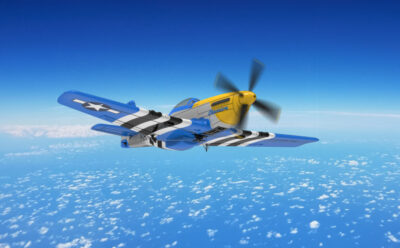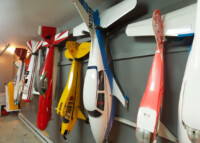Are Remote Control Warbirds Difficult to Fly?
7 November 2023 | Updated on November 09, 2023
Remote control (RC) warbirds have been a favorite among hobbyists and aviation enthusiasts for decades. These scale models of military aircraft from historical eras such as World War II are designed to be flown using remote controls.
One of the common questions that people ask about these airplanes is whether they are difficult to fly. The answer to this question is not straightforward, as several factors can influence the difficulty level. In this section, we will explore this question and provide insights into what makes these planes challenging to fly.

Key Takeaways:
- RC warbird airplanes are scale models of historical military aircraft.
- The difficulty of flying RC warbirds depends on several factors such as aircraft size, weight, and the pilot’s experience and skill level.
- With proper training and skill development, anyone can learn to fly RC warbirds successfully.
- Practicing on a simulator before flying the real aircraft and understanding the control surfaces and their functions can help improve flying skills.
- Selecting the right aircraft for your skill level and gradually increasing the complexity of maneuvers are essential tips for flying RC warbird airplanes successfully.
Understanding RC Warbirds
Before delving into the difficulty of flying RC warbird airplanes, it’s essential to understand what they are. RC warbirds are scale models of historical military aircraft, such as the P-51 Mustang, Spitfire, B-17 Flying Fortress, and many others. These aircraft are built to be remotely controlled by aviation enthusiasts and hobbyists.
They are designed to be highly detailed and often feature retractable landing gear, working propellers, and other realistic design elements. Their appearance accurately portrays the original aircraft they were modeled on, making them a must-have for any aviation aficionado.
In terms of flying capabilities, RC warbird airplanes can perform various maneuvers, such as loops, rolls, and inverted flight, just like their real-life counterparts. However, flying them can be quite different from other types of remote control planes, as they require a specific set of skills and knowledge.
The Types of RC Warbird Airplanes
There are various types of RC warbird airplanes, and each has its own set of characteristics that make them unique. Some of the most common types of RC warbirds include:
- Park Flyers: These are small, lightweight RC warbirds designed for flying in small spaces like parks or backyards. They are easy to fly and ideal for beginners.
- Electric Warbirds: These are larger than park flyers and run on electric motors. They are capable of performing more complex maneuvers and are suitable for intermediate pilots.
- Gas-Powered Warbirds: These are the largest and most powerful of the three types and use gas engines to fly. They require advanced skills and experience to fly.
No matter the type of RC warbird, the one thing they have in common is how they’re controlled, which brings us to our next point.
How RC Warbird Airplanes Are Controlled
RC warbird airplanes are typically controlled using a transmitter, which is operated by the pilot on the ground. The transmitter sends signals to the aircraft, controlling its movements, such as the throttle, ailerons, elevator, and rudder.
Each control has a specific function, and mastering them is essential to fly RC warbirds successfully. The ailerons control the roll, the elevator controls the pitch, the rudder controls the yaw, and the throttle controls the speed. Understanding each control’s function and how to use them in tandem is crucial to maneuver the aircraft effectively.
Some RC warbirds also come equipped with additional features, such as retractable landing gear and flaps, adding to their complexity and realism.
Now that we have a better understanding of what RC warbird airplanes are and how they’re controlled, let’s dive into the difficulty of flying them in the next section.
Factors Affecting Difficulty of Flying RC Warbirds
Flying RC warbird airplanes can be both exciting and challenging, especially for those who are new to the hobby. In this section, we will explore the factors that can affect the difficulty of flying these remote-controlled warbirds.
Size and Weight of the Aircraft
The size and weight of an RC warbird airplane can significantly impact its ease of flying. Larger and heavier aircraft can be more challenging to control, especially when it comes to takeoff, landing, and maneuvering in the air. However, they can also provide a more stable flight experience once in the air. Smaller and lighter aircraft can be easier to control but can also be more susceptible to wind and turbulence.
Flight Characteristics
Each RC warbird airplane has its unique flight characteristics, such as wing loading, stall speed, and aerodynamics. These characteristics can affect how the aircraft behaves in the air, making it more or less difficult to control. Some models may be naturally more stable, while others may be more sensitive to inputs. Understanding the flight characteristics of your specific model is crucial to successfully flying it.

Complexity of the Control System
The control system of an RC warbird airplane can range from simple to complex, depending on the model. Some aircraft may have basic controls, while others may have advanced features, such as retractable landing gear, flaps, and other movable parts. Operating a more complex control system can be challenging, especially for beginners. It is essential to have a good understanding of your aircraft’s control system and its functions before attempting to fly.
Pilot Experience and Skill Level
Perhaps the most crucial factor in determining the difficulty of flying an RC warbird airplane is the pilot’s experience and skill level. Flying remote control warbirds requires a range of skills, including hand-eye coordination, situational awareness, and reaction time. Pilots with more experience and skill will naturally find it easier to control the aircraft, while those who are new to the hobby may need more practice and training.

Photo by Gerry Yarrish
Tips for Flying RC Warbird Airplanes Successfully
Flying remote-controlled warbirds can be a challenging and rewarding experience. However, it requires careful attention to the details of the aircraft and the right techniques to control it effectively. Here are some tips and tricks to help you successfully fly an RC warbird airplane:
- Select the Right Aircraft: Choose an aircraft that matches your skill level and experience. Starting with a beginner-friendly model can help you build your confidence and improve your flying skills before trying more complex planes.
- Use a Simulator: Practice flying your RC warbird airplane on a simulator before flying the real aircraft. This will help you get a feel for the controls and learn how the airplane responds to your commands.
- Understand the Controls: Know how to use the different control surfaces of your aircraft, including the rudder, elevator, and ailerons, and how they affect its flight characteristics.
- Start Slow: Begin by flying your RC warbird airplane in a straight line and gradually increase your speed. Be patient and take your time to learn how your airplane behaves in the air.
- Practice Basic Maneuvers: Learn basic maneuvers like turns, climbs, and descents. Once you have mastered these maneuvers, you can move on to more advanced techniques like loops and rolls.
- Be Prepared for Wind: Wind can have a significant impact on your RC warbird airplane’s flight performance. When flying in windy conditions, be prepared to adjust your controls and stay alert to changing conditions.
- Join a Flying Club: Joining a local flying club can be a great way to connect with other RC warbird airplane enthusiasts and get valuable tips and feedback on your flying.
By following these tips and practicing regularly, you can overcome the challenges of flying RC warbird airplanes and enjoy the thrill of piloting these iconic aircraft from history.
Conclusion
RC warbird airplanes can be a thrilling and rewarding hobby for aviation enthusiasts. While they can be difficult to fly, especially for beginners, with patience, practice, and dedication, anyone can master the art of flying these scale models of historical aircraft.
It’s important to understand the factors that can impact the difficulty level of flying RC warbirds, such as the size and weight of the aircraft, its flight characteristics, and the complexity of the control system. By selecting the right type of aircraft for your skill level and gradually building up your flying experience, you can improve your skills and feel confident in maneuvering the aircraft.
Additionally, it’s helpful to utilize some tips and tricks for successful flying, such as practicing on a simulator, understanding the control surfaces, and gradually increasing the complexity of maneuvers. These strategies can help you gain confidence and make the experience of flying RC warbirds more enjoyable.
In conclusion, while RC warbird airplanes may be difficult to fly, they provide a unique and exciting opportunity to engage with aviation history. With the right approach and commitment, anyone can learn to fly these iconic aircraft successfully.
Our Recommendation
If you’re just getting started with RC warbirds, the LEAMBE Remote Control Mustang is a great RC warbird that’s easy to fly and extremely affordable!
FAQ
Are RC warbirds hard to fly?
RC warbird airplanes can have varying levels of difficulty to fly. Factors such as the type of aircraft, pilot experience, and necessary skills can influence the difficulty level.
What are RC warbirds?
RC warbird airplanes are scale models of military aircraft from World War II and other eras. They are remote-controlled by hobbyists and aviation enthusiasts and often feature realistic design elements.
What factors affect the difficulty of flying RC warbird airplanes?
The size and weight of the aircraft, its flight characteristics, the complexity of the control system, and the pilot’s experience and skill level can all impact the difficulty of flying RC warbird airplanes.
What are some tips for flying RC warbird airplanes successfully?
Some tips for successful flying include selecting the right aircraft for your skill level, practicing on a simulator, understanding the control surfaces, and gradually increasing the complexity of maneuvers.
Can anyone learn to fly RC warbirds?
Yes, with the right approach, practice, and understanding of the aircraft’s characteristics, anyone can learn to fly RC warbird airplanes successfully.







